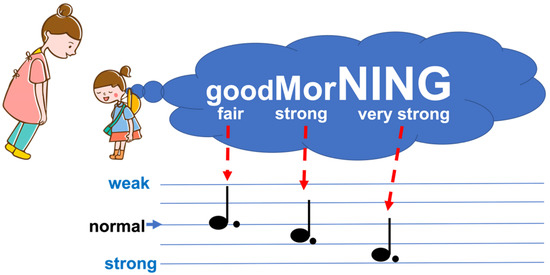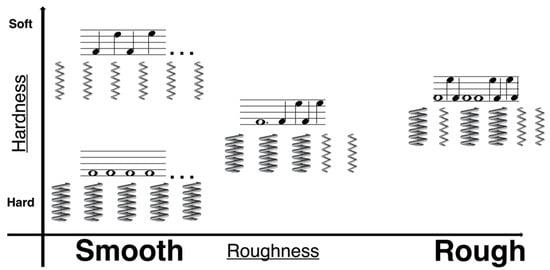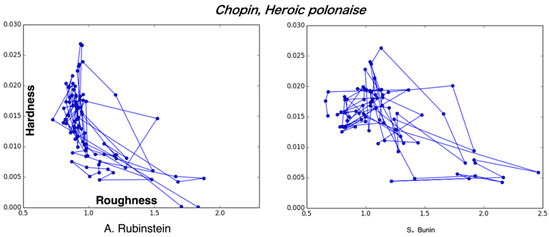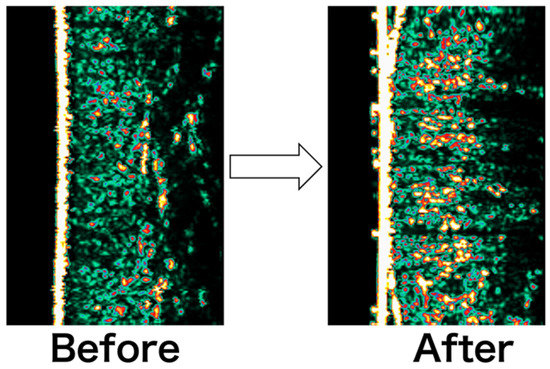Abstract
We construct a natural computing system based on the sense of touch. The natural computing system we construct does not depend on the conventional category of computer science. The computing consists of a computing entity and an algorithm. We define an algorithm as “a list of instructions for solving a problem” and a computing system as “the act or process of calculating an answer or amount by using an algorithm”.
1. Introduction
A heartfelt “thank you” is comforting, while a throwaway “thank you” is off-putting. Differences in the way we say things (i.e., temporal changes in speech sounds) change the emotions, or sensibilities, that accompany our senses [1,2]. Emotional understanding through speech sounds is thought to be mediated by mechanisms embedded in the sensory, cognitive, and emotional processing systems [1,2].
The written word conveys meaning; the spoken word brings sensibility [1,2]. In the natural world, information is communicated through somatosensory communication in the broadest sense [3]. Viruses are transmitted by mutations that change the way they are “touched” and induce a “pleasant feeling” in the sugar chains on the surface of the cells they contact [4]. Vine-wrapping plants decide whether to wrap around a vine by waving it around and “touching” the foreign object they encounter [5]. Female-male mice interactions are suggested mainly via somatosensory input [6,7].
“Sensibility refers to an acute perception of or responsiveness towards something” [8]. Tactile interaction in nature is the communication of sensibility, where precise interaction does not involve writing or language.
The aim of this research is an algorithmic understanding of tactile interaction. Information and the manipulation of information are phenomena, the principles of which form the basis of the metascience of information, where the basic properties of phenomena are given by algorithm [9]. The algorithm is “a finite sequence of well-defined instructions” [10]. This research is positioned as natural computing; “Natural Computing refers to computational processes observed in nature, and human-designed computing inspired by nature” [11].
2. Method
Complex phenomena, such as tactile interaction, involve many “variables”. Music is a complex phenomenon with many notes. Still, a musical score represents a sound note with only one variable—the time variation of the pitch.
We describe tactile interaction only in terms of temporal changes in a single variable, intensity. We illustrate tactile interactions with only one variable, intensity. It corresponds to the temporal evolution of the sound volume of “speech” or the temporal change of contact force in the case of “touch” between a cell surface and a sugar chain or between a vine and a foreign substance.
Tactile Score
We proposed a musical notation (stave) to describe the tactile interaction—the Tactile Score [12] (Figure 1). The stave’s middle line (the third line) represents “normal” intensity. Below, the lines below the third line represents “high” intensity, the lines above the third line represent “low” intensity, and the notes represent rhythm of tactile sense.

Figure 1.
Tactile Score of Good Morning; the girl is chirping, where the Tactile Score illustrates the pressure of tone of voice.
The sensations evoked by the sense of touch are called “tactile qualities” [13]. Previous research has confirmed that tactile quality (Figure 2), “hardness”, “roughness”, and “temperature” are essential in this order [14].

Figure 2.
The vertical axis indicates hardness—harder at the bottom, softer at the top. The horizontal axis indicates roughness—the more uniform the hardness, the smoother the Tactile Score pattern; the more non-uniform the hardness, the rougher the pattern.
We can quantify tactile notation’s “hardness” by analogy with springs. The displacement of a spring is in proportion to the force applied to it. If the same pressure pushes two springs, the stiffer spring has a smaller displacement, and the softer spring has a larger displacement. Roughness is defined as the complexity of the Tactile Score pattern. If the pattern of the Tactile Score is uniform, smoothness is indicated; if the Tactile Score is non-uniform, roughness is indicated, as shown in Figure 2.
3. Result
The Tactile Score makes it possible to generate sensory information that elicits the desired sensitivity [15]. We analyzed the Tactile Score transcription of a hand massage that has been used in over 200,000 interventions [12,15]. We extracted a “grammar” of the Tactile Score from the analysis of our expert technician’s massage, which elicited a reduction in facial contours and an increase in skin tone luminosity [15]. The Tactile Score describes a time series of changes in strength. By replacing any time-series change with a time series of intensity, we can obtain the tactile quality of the time-series change.
The Tactile Score can be used to describe tactile sensations and sensory information that arouses sensitivity. The piano is a tactile instrument. The touch to the keyboard is directly converted into sound. Unlike a stringed instrument, it is not possible to adjust the sound. This is why the piano is called a “stringed percussion instrument”.
We compared the performances of Chopin’s Heroic Polonaise by A. Rubinstein, who was called the master, and S. Bunin, who was considered to be a revolutionary. Each sound source was converted into a Tactile Score at 0.01 s intervals, and we examined the average of the time-changing of “hardness” and “roughness”. Rubinstein’s performance exhibited dominant roughness and with a variety of “hardnesses”, while Bunin’s performance had a variety of roughness and was slightly softer than Rubinstein’s performance (Figure 3).

Figure 3.
Tactile qualities of notes played by Rubinstein (left) and Bunin (right) on Chopin’s Heroic Polonaise. The vertical axis indicates hardness; the horizontal axis indicates roughness. The graphs plot the average hardness and roughness of the notes played every 0.01 s.
3.1. Digitalization of Tactile Sense
The Tactile Score describes a change in intensity: a vibration transducer can transform pure tone sine wave data, such as files in WAV or mp3 format, to vibrotactile. By varying the amplitude of a pure tone sine wave described in the Tactile Score, a pure tone can be converted to a vibrotactile sensation.
The grammar of the Tactile Score is the grammar of a skilled massage specialist’s technique. When this technique is applied to the skin, a high cosmetic effect is achieved. We composed a Tactile Score according to this grammar, transformed vibrotactile sensations, and confirmed which applications possess cosmetic effects [14].
We started a project with a beauty care company to create and provide vibrotactile sensations with a Tactile Score. Due to the spread of the new coronavirus disease in 2021, we offered the service only via internet distribution. We launched a trial service operation in April 2021. In a six-month period, under self-restraint to avoid the spread of infectious diseases, we engaged 1000 paid users with about 200,000 accesses per month. Social experiments have also demonstrated the vibrotactile sensation created from the Tactile Score [15].
We explored the vibrotactile sensation of collagen fiber aggregation, using the Tactile Score. In collaboration with a biochemistry laboratory, we presented vibrotactile feelings on the human face and analyzed the responses using skin ultrasound cross-sectional images [15]. On the other hand, we also confirmed that some vibrations do not show an aggregation effect. The skin showed a more selective and sensitive response to tactile sensations than expected.
There are two types of tactile interaction—direct and indirect. We were interested in the indirect tactile interaction of low-frequency sound.
3.2. Touch without Touching
Sound is produced when energy vibrates a medium. If energy vibrates a medium 100 times and uses up all the power in one second, it can create a 100 Hz vibration. If the energy is used up in one second, the medium will vibrate at 100 Hz, but if it is reduced to 10 vibrations per second, the medium will vibrate at 10 Hz for 10 s. The energy of one vibration wave of 10 Hz is 10 times greater than that of 100 Hz.
Low-frequency sound vibrates deep into the bones and tissues of the body because of its high energy.
It is known that collagen fibers in the skin aggregate with low-frequency vibrations [16], but it has been reported that prolonged vibration of the skin with pure (non-overtone) low frequencies can “age” the skin [17] (Figure 4).

Figure 4.
Before (left) and after (right) applications of vibrotactile sensations transformed, according to the Tactile Score, to the skin using DermaLab to measure skin ultrasound cross-sections and to investigate the distribution of collagen fibers in the dermal layer. The dots in the figure are collagen fibers.
4. Final Remarks: Building Tactileology
There is still no effective treatment for dementia. As dementia progresses, attenuation of the gamma waves of the electroencephalogram (EEG) has been observed. Professor Tsai and colleagues at the Massachusetts Institute of Technology found that exposure of Alzheimer’s-diseased mice to 40 Hz visual stimulation (flickering light) and low-frequency sound halved the amount of amyloid-beta and other causative agents [18,19].
In collaboration with Professor Hidetaka Ohta and colleagues at the Akita University Research Center for Advanced Gerontology, we are conducting a clinical study in which patients with dementia are exposed to 40 Hz sound. We have found statistically significant improvements in working memory and depression [20].
Funding
This research received no external funding.
Institutional Review Board Statement
The study was conducted in accordance with the Declaration of Helsinki, and approved by the Ethics Committee of Nagoya University for studies involving humans.
Informed Consent Statement
Informed consent was obtained from all subjects involved in the study.
Data Availability Statement
Not applicable.
Conflicts of Interest
The author declares no conflict of interest.
References
- Schirmer, A.; Kotz, S.A. Beyond the right hemisphere: Brain mechanisms mediating vocal emotional processing. Trends Cogn. Sci. 2006, 10, 24–30. [Google Scholar] [CrossRef] [PubMed]
- Kraus, M.W. Voice-only communication enhances empathic accuracy. Am. Psychol. 2017, 72, 644. [Google Scholar] [CrossRef] [PubMed] [Green Version]
- Saal, H.P.; Bensmaia, S.J. Touch is a team effort: Interplay of submodalities in cutaneous sensibility. Trends Neurosci. 2014, 37, 689–697. [Google Scholar] [CrossRef] [PubMed]
- Kim, S.H.; Kearns, F.L.; Rosenfeld, M.A.; Casalino, L.; Papanikolas, M.J.; Simmerling, C.; Freeman, R. GlycoGrip: Cell Surface-Inspired Universal Sensor for Betacoronaviruses. ACS Cent. Sci. 2022, 8, 22–42. [Google Scholar] [CrossRef]
- Fukano, Y. Vine tendrils use contact chemoreception to avoid conspecific leaves. Proc. R. Soc. B Biol. Sci. 2017, 284, 20162650. [Google Scholar] [CrossRef] [Green Version]
- Bobrov, E.; Wolfe, J.; Rao, R.P.; Brecht, M. The representation of social facial touch in rat barrel cortex. Curr. Biol. 2014, 24, 109–115. [Google Scholar] [CrossRef] [PubMed] [Green Version]
- Chen, P.; Hong, W. Neural circuit mechanisms of social behavior. Neuron 2018, 98, 16–30. [Google Scholar] [CrossRef] [PubMed] [Green Version]
- Wikipedia “Sensibility”. Available online: https://en.wikipedia.org/wiki/Sensibilit (accessed on 4 January 2022).
- Otten, K.; Debons, A. Towards a metascience of information: Informatology. J. Am. Soc. Inf. Sci. 1970, 21, 89–94. [Google Scholar] [CrossRef]
- Wikipedia “Algorithm”. Available online: https://en.wikipedia.org/wiki/Algorithm (accessed on 4 January 2022).
- From Natural Computing, Journal Home Page. Available online: https://www.springer.com/journal/11047 (accessed on 4 January 2022).
- Suzuki, Y.; Suzuki, R.; Suzuki, R. Tactile Score: A Knowledge Media for Tactile Sense; Springer: Tokyo, Japan, 2014. [Google Scholar]
- Tiwana, M.I.; Redmond, S.J.; Lovell, N.H. A review of tactile sensing technologies with applications in biomedical engineering. Sens. Actuators A Phys. 2012, 179, 17–31. [Google Scholar] [CrossRef]
- Suzuki, Y.; Suzuki, R. Computational Aesthetics: From Tactile Score to Sensory Language. In Pervasive Haptics; Kajimoto, H., Saga, S., Konyo, M., Eds.; Springer: Tokyo, Japan, 2016. [Google Scholar] [CrossRef]
- Suzuki, Y. IoT of Sensibility by Using Tactile Score and Its Application for Sensibility Informotion. J. Jpn. Soc. Appl. Electromagn. Mech. 2019, 27, 396–401. [Google Scholar] [CrossRef]
- Alves-Pereira, M.; Branco, N.A.C. Vibroacoustic disease: Biological effects of infrasound and low-frequency noise explained by mechanotransduction cellular signalling. Prog. Biophys. Mol. Biol. 2007, 93, 256–279. [Google Scholar] [CrossRef] [PubMed]
- Boughner, D.R.; Roach, M.R. Effect of low frequency vibration on the arterial wall. Circ. Res. 1971, 29, 136–144. [Google Scholar] [CrossRef] [Green Version]
- Uhlhaas, P.J.; Singer, W. Neural synchrony in brain disorders: Relevance for cognitive dysfunctions and pathophysiology. Neuron 2006, 52, 155–168. [Google Scholar] [CrossRef] [PubMed] [Green Version]
- Martorell, A.J.; Paulson, A.L.; Suk, H.J.; Abdurrob, F.; Drummond, G.T.; Guan, W.; Young, J.Z.; Kim, D.N.-W.; Kritskiy, O.; Barker, S.J.; et al. Multi-sensory gamma stimulation ameliorates Alzheimer’s-associated pathology and improves cognition. Cell 2019, 177, 256–271. [Google Scholar] [CrossRef] [PubMed] [Green Version]
- Kodama, A.; Suzuki, Y.; Kume, Y.; Ota, H. Examination of the effect of Deep Micro Vibrotactile stimulation on cognitive function for elderly with Alzheimer’s Disease. Ann. Alzheimer’s Dement. Care 2021, 5, 1–3. [Google Scholar]
Publisher’s Note: MDPI stays neutral with regard to jurisdictional claims in published maps and institutional affiliations. |
© 2022 by the author. Licensee MDPI, Basel, Switzerland. This article is an open access article distributed under the terms and conditions of the Creative Commons Attribution (CC BY) license (https://creativecommons.org/licenses/by/4.0/).